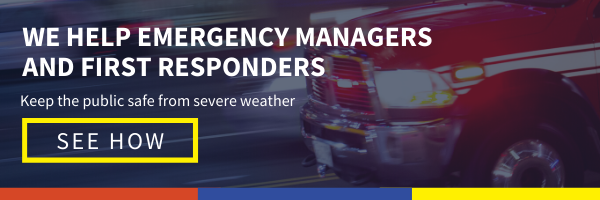8 Tips for Emergency Managers on Preparing for Severe Weather
- Dec 10, 2019
Is your emergency management team ready for the next severe weather event?

We know that state and local emergency management crews are responsible for keeping communities safe during both planned and unplanned events. And they do this with limited resources and a workforce that is largely part-time in the most severe-weather prone country in the world.
When the Emergency Operations Center (EOC) is activated for a severe weather event, it’s generally for something major like a hurricane or something sudden and unexpected like flash flooding. Your team may have experienced this type of event before, or planned ahead for what to do, but these events can still present a challenge.
Weather Tips from Emergency Managers
We asked emergency managers from across the United States to share their stories and lessons learned from managing severe weather events. We heard about everything from keeping students and teachers safe during a tornado to operating the emergency department of a hospital during Hurricane Katrina.
The single most important lesson from emergency managers for emergency managers is to prepare a back-up communications plan.

The electrical grid may go down, cell phone towers can get jammed. Whatever your primary mode of communication, prepare for it to fail and then prepare for your back-up plan to fail and then you might be adequately prepared.
Here are 8 tips for preparing for an emergency weather event:
1. Expect the unexpected
Every storm is different and even “normal” summer thunderstorms or “low-level” Category 1 hurricanes can cause significant damage.
2. Line up resources in advance
Whether you’re competing for resources with neighboring communities or your emergency staff only works part time, the sooner you can line up your resources, the better.
3. Set up a mass communications plan
Pushing out a consistent, up-to-date message on multiple channels (social media, website, news, etc.) to keep the public informed takes time that you may not have during an emergency. Craft your mass communications plan now and save time later.
4. Establish back-up communications for first responders
Keeping the public informed is only half the battle, you can’t coordinate an effective emergency response if you can’t communicate with responders.
5. Take care of your responders
Basic needs like eating or drinking water can get lost when you’re on the front lines. Make sure you take care of your responders and not just the people they rescue!
6. Test communication lines early and often
When a Severe Weather Watch is issued, use that early warning to test communication lines and make sure everything is functioning properly so that you’re ready if the storm is upgraded to a Warning.
7. Track the path of the storm
Many factors contribute to the path a storm will take and how severe it will be. As the storm approaches your area, be sure to monitor its evolution using radar, lightning detection, and surface observation networks.
8. Generate external partner buy-in before the storm
When a weather emergency strikes, you’ll need all the help you can get. Try to generate the most buy-in possible on a sunny day to help external partners understand the important of planning for inclement weather.
Flip through the book below to read their stories in full.

Do you work in emergency management? Share your story.
And scroll down to check out our 4-step plan to improve weather-readiness in your community:







